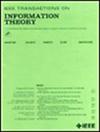通过网络进行密钥转换
IF 2.2
3区 计算机科学
Q3 COMPUTER SCIENCE, INFORMATION SYSTEMS
引用次数: 0
摘要
对于多源多终端无噪声网络,组播密钥分发问题(这里称为密钥组播问题)涉及从网络源向终端组播(秘密)密钥 K 的任务。传统通信中,信息必须原封不动地从信息源传送到目的地,而密钥传送与之不同,它更加灵活,因为密钥传送不需要在目的地节点重建信息源。相反,分布式密钥可以是来源的混合物,来源本身可能无法恢复。过去几十年来,人们对无记忆网络中的密钥传输(也称为密钥协议)进行了大量研究。这项工作开启了对无噪声网络(即网络编码)中密钥传输的研究,并探讨了需要源重构的传统通信形式与密钥传输任务中限制较少的通信形式之间的异同。这项研究根据三个标准而有所不同。环境可以是安全的,在这种情况下,共享密钥不会泄露给窃听者(我们对窃听者的能力进行了限制);也可以是非安全的,在这种情况下,密钥无需隐藏。设置中可以有一个或多个源节点,能够生成独立的随机性,用于密钥生成过程。此外,还可以有一个或多个终端集,后一种情况被称为多重密钥传送。在多密钥传送中,要求每个终端集中的终端解码不同的共享密钥。在给定的环境下,这项研究推导出了密钥传送和多重密钥传送的组合条件,并设计了相应的通信方案。此外,研究还比较了有源重构限制和无源重构限制下的密钥传输率。当放宽源重构限制时,密钥传送在速率上具有绝对优势。本文章由计算机程序翻译,如有差异,请以英文原文为准。
Key-Cast Over Networks
For a multi-source multi-terminal noiseless network, the multicast key-dissemination problem, here called the key-cast problem, involves the task of multicasting a (secret) key K from the network sources to its terminals. Unlike traditional communication, where messages must be delivered from source to destination(s) unchanged, key-cast is more flexible since key-cast need not require source reconstruction at destination nodes. Instead, the distributed key can be a mixture of sources from which the sources themselves may be unrecoverable. Key-cast (also known as secret key agreement) in memoryless networks has seen significant studies over the past decades. This work initiates the study of key-cast in noiseless networks, i.e., network coding, and addresses the similarities and differences between traditional forms of communication that require source reconstruction and the less constrained form of communication in the key-cast task. The study varies according to three criteria. The setting can be secure, in which case the shared key is not revealed to an eavesdropper (whose capabilities we constrain), or non-secure, in which case the key need not be hidden. The setting can have one or multiple source nodes capable of generating independent randomness to be used in the key generation process. And the setting can have one or multiple terminal sets, where the latter case is referred to as multiple key-cast. In multiple key-cast, one requires that terminals in each terminal set decode a different shared key. In the given settings, this work derives combinatorial conditions for key-cast and multiple key-cast and designs corresponding communication schemes. In addition, the study compares the key-cast rate with and without the restriction of source reconstruction that is needed in traditional forms of communication. Key-cast achieves a strict advantage in rate when source reconstruction is relaxed.
求助全文
通过发布文献求助,成功后即可免费获取论文全文。
去求助
来源期刊

IEEE Transactions on Information Theory
工程技术-工程:电子与电气
CiteScore
5.70
自引率
20.00%
发文量
514
审稿时长
12 months
期刊介绍:
The IEEE Transactions on Information Theory is a journal that publishes theoretical and experimental papers concerned with the transmission, processing, and utilization of information. The boundaries of acceptable subject matter are intentionally not sharply delimited. Rather, it is hoped that as the focus of research activity changes, a flexible policy will permit this Transactions to follow suit. Current appropriate topics are best reflected by recent Tables of Contents; they are summarized in the titles of editorial areas that appear on the inside front cover.
 求助内容:
求助内容: 应助结果提醒方式:
应助结果提醒方式:


